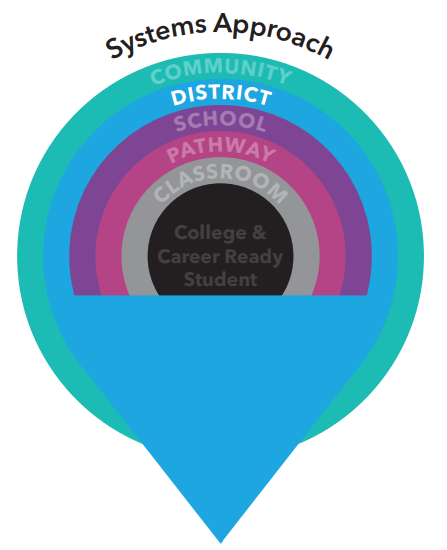
Role of the District
The role of the district in the system is to ensure that the work of college and career readiness is elevated above the level of a programmatic or even a department offering to the level of a cross-district approach. This requires that the district aligns the work with other initiatives, designates collaborators in all relevant departments, and incorporates the work into all supportive infrastructures and development plans in the district. It is up to the district to keep the work maintained at such a level that the school board, community, and entire district are regularly engaged in and informed about college and career readiness activities and impact
District Domains and Resources

District and school leaders, the business community, local postsecondary institutions, labor unions, and community and parent groups commit to a shared vision and dedicate the necessary resources to put the vision into practice and sustain it. Leaders commit to regular examination of pathway quality with the objective of moving each pathway to a high level of quality. Pathway improvement is directly aligned with and measured by student outcomes related to a set of college, career, and community readiness indicators. Leaders also commit to supporting ongoing pathway improvement.
Domain Resources:

The superintendent and board set the expectation that pathways will appeal to be used to engage and successfully serve any student regardless of his or her prior academic achievement, language proficiency, or postsecondary aspirations. No matter what pathway areas of focus and delivery models are established; students in the district have equal access to any pathway based on interest alone. District leaders expect middle grade administrators and teachers to support students in making an informed pathway choice at the end of their 8th grade year by ensuring that students are exposed to career opportunities in a variety of industry sectors and know their high school pathway options. As important, students are academically prepared to succeed in rigorous pathway programs of study and are assisted in making the transition from middle school to high school pathways.
Domain Resources:

The district articulates a clear description of powerful student learning and the instructional practices that support that learning to ensure that every student attains the outcomes described in the graduate profile. The district organizes and aligns support systems for curriculum, assessment, instruction, and professional development based upon an assessment of both students’ and teachers’ strengths and needs in relation to outcomes, regularly solicits input and feedback from students and teachers, and examines evidence of student learning to continuously improve effectiveness.
Understanding that pathway quality depends upon teachers’ ability to work effectively as a Community of Practice and opportunities for students to collaborate regularly on multi-disciplinary projects; the district’s secondary education director and high school principals commit to developing master schedules that guarantee common planning time for grade-level teams of pathway teachers and cohort scheduling for pathway students.
Domain Resources:

Preparing students for college, career, and community success is not solely an effort to transform high schools and the student experience; it is also a strategy for preparing the future workforce, expanding the regional economy, and improving conditions for those who live in the region. Students graduating from pathways should enjoy a seamless transition to postsecondary education and training options. These transitions are facilitated by strong, active partnerships with local postsecondary institutions and by leveraging the support of employers and civic and community leaders in establishing and sustaining high-quality pathways. Through such partnerships, communities can over time develop a qualified, diverse workforce and positively affect broader social and economic indicators.
Domain Resources:

Throughout all facets of district operations, leaders align policies, practices, and resources to support pathway development and quality. In particular, human resource policies and practices support the unique instructional and leadership needs of pathways. District facilities will need to accommodate and support the teaching and learning needs of pathway programs of study. To accomplish this objective, districts may need to reconfigure or reassign existing space, plan for expansion or renovation, and/or consider sharing facilities with other educational or community organizations. Similarly, districts may need to invest to ensure that appropriate equipment is made available to support the particular teaching and learning needs of pathways with different career or industry themes.
Domain Resources:
)